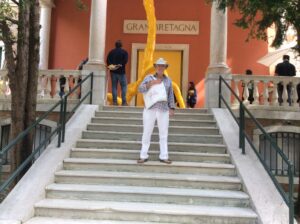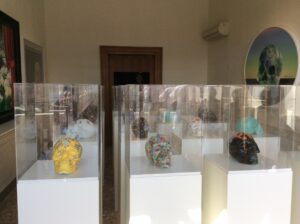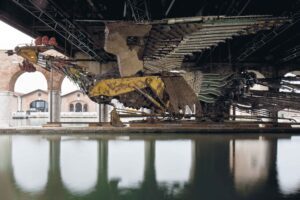

The first Venice Biennale took place in 1895 and 120 years later prospers as the oldest and probably most famous of the many international gatherings for contemporary art and architecture.
This year’s Biennale opened on Friday 8th May in the Giardini Gardens, a gentle stroll alongside the lagoon beyond the famous Piazza San Marco described by Napoleon as ‘Europe’s sitting room’. This parkland setting is home to some 30 national pavilions, the oldest of which is the British Pavilion, acquired in 1909. It is on the highest ground but still only a few metres above sea level and is built on the remains of the Campanile di San Marco which collapsed spectacularly at the turn of the 20th century.
You need only to know that Tiepolo was born nearby and Vivaldi lived just around the corner for your spirits to soar. This was only my second visit to Venice and the Biennale, my first being 19 years ago when I attended the VI Venice Architecture Biennale when the Eden Project represented Great Britain. I attended as client and Project Co-founder.
It is this cultural, aquatic spaghetti junction where art, architecture and music intermingle and collide that is its very raison d’être, and provides compulsion and longevity to the Biennale.
I headed first to the British Pavilion and to the much publicised Sarah Lucas exhibition, I SCREAM DADDIO. Always lauded in the second tier of the YBA, enlightenment is in short supply for the casual observer. I am not sure what sort of metaphor are lower torsos with cigarettes strategically protruding from orifices – wacky baccy perhaps? I loved the custard yellow of the Pavilion but I was left wondering about intellectual and historical foundations and whether the long gone Campanile was not the only thing at risk of coming tumbling down. Is truth a casualty to celebrity in these times? Surely the British exhibit answers the question of where we are in the world. But what is this saying of us? Is it a smoker’s protest to the puritan politics of our times? Is it saying the internet has now made pornography so inescapable we had better get used to ubiquitous, naked titillation?

Perhaps it is indeed symptomatic of a Britain all at sea in its identity, afloat in uncertainty of whether we are inside or outside Europe and whether, indeed, the Kingdom is to remain United.
This exhibition belongs to a time that has long gone when shock, not skill, was all the rage.
Some forty years before the first Biennale in 1895, John Ruskin produced his masterpiece The Stones of Venice and it remains Venice’s Bible for architects. A handsome city where the hand of God has given so much and this is so beautifully captured by Ruskin’s draughtsmanship, prose and poetry, and commentary on decay and departed decadence. On this visit I took with me the newly published Ruskin’s Venice, The Stones Revisited by Sarah Quill and this volume was close at hand throughout my stay as an aid to context and awareness.
Waking up the first morning in Venice is an experience like no other. A tolling Campanile greets the day, its call discordant. My bedroom window on Venice’s world is a top floor Grand Canal bird’s eye view. To my left the Rialto Bridge and immediately below and to my right are thirty parked up gondolas in serried ranks all sheathed in blue canvas covers, save one, a camping green. One anchor pole to bow, and one to stern takes a single turn of painter through the night. The first gondolier is unwrapping his day. First the stern section of the two separate canvas pieces is rolled back with cat like tread that would have seen you or I tumbling into the Canal Grande. The bigger bow canvas follows, is folded and stowed, the glitter and gilt of the midships seat catches the morning sun. The paddle, the seats and the velvet cushions all assume their place.
And so as the fishmonger’s day in the market on the opposite side of the canal nears its end of labour with shadows shortening to the rising sun, the gondolier’s glorious, profitable, operatic day is about to begin.
The pantile topped canal side façades display such genteel distress above and who knows what below

the waterline. But what enclosure, what space to co-inhabit what perfect equilibrium of nature and man; this is the Venetian alchemy and why it has enjoyed its must-see status down the ages.
This tolling dawn bell implores, why waste a moment, it says. There is so much to see.
The thirty or so exhibits in the Biennale Gardens are but a small part of what Venice has to offer during the exhibition. All Expos have journeyed from the Great Exhibition of 1851 in London capturing the spirit of each age. Here in Venice evidence abounds of the ever more intrusive technology in our lives. Vast cruise liners ply their invasive lagoon pathways daily, incongruous in their scale and disturbing in their commerce. They cast monstrous shadows, metaphorical and physical in their late afternoon passage, obscuring western sun.
Our Biennale opening night has us accepting an invitation at La Galleria-Venezia, a mere canal’s width away from La Fenice. We attend a celebration of 35 years Gallery ownership by Dr Dorothea van der Koelen in Mainz, Germany with her playing a major part in the Biennale these past 10 years. According to Philip Rylands, Director of the Peggy Guggenheim Collection, this is the best international gallery of Venice. The theme is Towards the Future. This holds much synergy for me as our Eden architecture exhibit of 19 years ago came under the theme of Sensing the Future. Alas our German is not sufficient to keep up with the introduction. Lore Bert’s PERSONAL STRUCTURES – Crossing Borders, exhibition is comfortable and thought provoking.
Other exhibitions leave you far outside your comfort zone. Beneath our top floor hotel rooms in the Palazzo Michiel Chinese artist Jiang Heng has set out with the intention of taking you, the observer, on a journey through the collapse of moral values in contemporary Chinese society, entitled Highway to Hell. I doubt there could be a more discordant presentation in the hallowed Piano Nobile in gentle distress at first floor level. The extravagant mouldings and painted ceilings, the exquisite proportions, the charming balcony projecting over the canal will surely never have accommodated such confrontation to well being.
The intention is to chart China’s rapid evolution from poor isolated nation into one of the world’s pre-eminent market powers but how this does not lead to happiness. Any fast moving market economy transforms habits and living standards, but with this comes a revolution in the desires and morals of a generation.
By the time you have traversed the landscape of pills that greet you as you enter and move through to the colourful but disturbing skulls and skeletons signifying the fragility and insignificance of life you are in desperate need of sunshine, fresh air and the restorative majesty of returning to the comfortable Grand Canal immediately beyond the skulls.
Between pill and skull I have passed the single most challenging exhibit of my Biennale week. It is called Device, a bare tree that is shedding Chinese-sub-brands of Barbi dolls instead of autumn leaves. The exhibition catalogue explains these dolls dispersed on all of the floor become corpses sacrificed to the idea of female beauty and its commodification promoted by the media in the West. I do not want to dally here. I want to move on quickly, but I cannot. It is a narrow point in the exhibition which is enjoying substantial footfall. Barbi corpses crunch beneath straying feet as pedestrian flow makes you barge and sway. Reaction to what you see detaches you from the normal courtesies of passing fellow man when in a crowded hurry. For me this is almost paedophilia. Jaing Heng’s future is scary.
We move on to Salute and to what I find is the most memorable and most enjoyable exhibition in the Biennale. It is entitled Expo ’67 Fragments: Alexander Calder and Emilio Vedova and is held in the Magazzino del Sale and Spazio Vedova. From Highway to Hell to Stroll down Memory Lane.
I was there in 1967 in Montreal, Canada and Cornwall’s Eden Project genesis and homage to Richard Buckminster Fuller started there. The explanatory notes to the exhibition by Germano Celant are erudite and comprehensive. They bring back so many vivid recollections, not least the spectacular stabile by Alexander Calder of ‘Man’ on the island of Sainte-Hélène a centrepiece of the World Expo. Man stood on a concrete plinth 20 metres high and weighing in at 46 tons. Here fragments have been gathered of this Expo of 48 years ago where Emilio Vedova represented Italian artists in Canada. Small scale models bearing witness to Calder’s working methods, one of Calder’s kinetic mobiles and a film of his working methods are a magnet.
But an architect will always put architecture first. The Magazzino del Sale by renowned architect Renzo Piano is the most inspiring contemporary space visited in the week. The gallery slopes upwards to the most extraordinary piece of technology, an automated handling and storage system for works of art. This is a unique arrangement. The storage facility, a piece of art in itself, is a rack system with the capacity for 30 works of art. A retrieval machine is used to deposit and retrieve works of art with automation managed by microprocessor. I stand mesmerised. An elderly art collector is escorted up to close by where I am standing and she sits in isolated splendour on an Alvar Aalto birch stacking stool. The whirring noises produce large canvases for her review and consideration.
Here we have a new dimension to the words ‘ private view’, The leading edge technology of our time combines with inspiring space created by the leading Italian architect of our age with a collector sitting on an Alvar Aalto stool – so timeless in its design.
Surely in any visit to Venice, the last word belongs to John Ruskin who coined the phrase ‘modern painters’:
‘It requires a strong effort of common sense to shake ourselves quit of all that we have been taught for the last two centuries, and wake to the perception of a truth just as simple and certain as it is new: that great art, whether expressing itself in words, colours, or stones, does not say the same thing over and over again; that the merit of architectural, as of every other art, consists in its saying new and different things; that to repeat itself is no more a characteristic of genius in marble than it is of genius in print; and that we may, without offending any laws of good taste, require of an architect, as we do of a novelist, that he should be not only correct, but entertaining. ‘
Amen to that.
Jonathan Ball MBE
Volume 30 number 1 August / September 2015 pp 12-15

